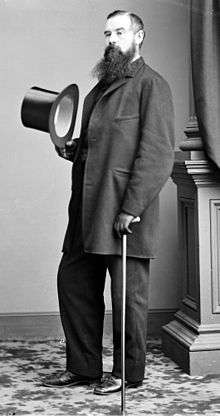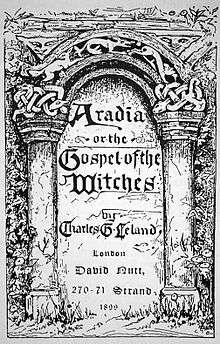Charles Godfrey Leland
| Charles Godfrey Leland | |
|---|---|
 | |
| Born |
15 August 1824 Philadelphia, Pennsylvania |
| Died |
20 March 1903 (aged 78) Florence, Italy |
| Signature | |
|
| |
Charles Godfrey Leland (August 15, 1824 – March 20, 1903) was an American humorist, writer, and folklorist, born in Philadelphia, Pennsylvania. He was educated at Princeton University and in Europe.
Leland worked in journalism, travelled extensively, and became interested in folklore and folk linguistics, publishing books and articles on American and European languages and folk traditions. He worked in a wide variety of trades, achieved recognition as the author of the comic Hans Breitmann’s Ballads,[1] fought in two conflicts, and wrote what was to become a primary source text for Neopaganism half a century later, Aradia, or the Gospel of the Witches.
Early life
Leland was born to Charles Leland, a commission merchant, and Charlotte Godfrey, on 15 August 1824 in Philadelphia, Pennsylvania. Leland told a story that shortly after his birth his nurse took him to the family attic and performed a ritual involving a Bible, a key, a knife, lighted candles, money and salt to ensure a long life as a "scholar and a wizard", a fact which his biographers have commented upon as foreshadowing his interest in folk traditions and magic.[2]
Leland's early education was in the United States, and he attended college at Princeton University. During his schooling, Leland studied languages, wrote poetry, and pursued a variety of other interests, including Hermeticism, Neoplatonism, and the writings of Rabelais and Villon.[3] After college, Leland went to Europe to continue his studies, first in Germany, at Heidelberg and Munich, and in 1848 at the Sorbonne in Paris. He got involved in the revolution that year, fighting at constructed barricades against the King's soldiers as a captain in the revolution.[4]
Career
Journalism
Leland returned to America after the money given to him by his father for travel had run out, and passed the bar in Pennsylvania. Instead of practicing law, he instead began a career in journalism. As a journalist, Leland wrote for The Illustrated News in New York, the Evening Bulletin in Philadelphia and eventually took on editorial duties for Graham's Magazine, and the Philadelphia Press. In 1856 Leland married Eliza Bella "Isabel" Fisher.[4]
Leland was also an editor for the Continental Monthly, a pro-Union Army publication. He enlisted in the Union Army in 1863, and fought at the Battle of Gettysburg. Leland coined the term "emancipation" as an alternative to "abolition" to refer to the anti-slavery position.[4]
Folklore research
Leland returned to Europe in 1869, and travelled widely, eventually settling in London. His fame during his lifetime rested chiefly on his comic Hans Breitmann’s Ballads (1871), written in a combination of broken English and German (not to be confused, as it often has been, with Pennsylvania German).[5] In recent times his writings on pagan and Aryan traditions have eclipsed the now largely forgotten Breitmann ballads, influencing the development of Wicca and modern paganism.
In his travels, he made a study of the Gypsies, on whom he wrote more than one book. Leland began to publish a number of books on ethnography, folklore and language. His writings on Algonquian and gypsy culture were part of the contemporary interest in pagan and Aryan traditions. Scholars have found Leland had taken significant liberties with his research. In his book The Algonquin Legends of New England Leland attempts to link Wabanki culture and history to the Norse. It has also come to light that Leland altered some of those folk tales in order to lend credence to his theory.[6] He erroneously claimed to have discovered "the fifth Celtic tongue": the form of Cant, spoken among Irish Travellers, which he named Shelta. Leland became president of the English Gypsy Lore Society in 1888.
Eleven years later Godfrey produced Aradia, or the Gospel of the Witches, reportedly containing the traditional beliefs of Italian witchcraft as conveyed him in a manuscript provided by a woman named Maddalena, whom he refers to as his "witch informant."[7] This remains his most influential book. Aradia's accuracy has been disputed,[8] and used by others as a study of witch lore in 19th century Italy.[9]
Art education
Leland was also a pioneer of art and design education, becoming an important influence on the Arts and Crafts movement. In his memoirs he wrote, "The story of what is to me by far the most interesting period of my life remains to be written. This embraces an account of my labour for many years in introducing Industrial Art as a branch of education in schools[.]"
He was involved in a series of books on industrial arts and crafts, including a title he co-authored in 1876 with Thomas Bolas, entitled "Pyrography or burnt-wood etching" (revised by Frank H Ball and G J Fowler in 1900). He was, more significantly, the founder and first director of the Public School of Industrial Art in Philadelphia.[10] This originated as a school to teach crafts to disadvantaged children and became widely known when it was praised by Oscar Wilde, who predicted his friend would be "recognised and honoured as one of the great pioneers and leaders of the art of the future."[11] The Home Arts and Industries Association was founded in imitation of this initiative.[12]
Translations
Leland translated the collective works of the German Romanticist Heinrich Heine,[13] and poems by Joseph Victor von Scheffel into English.[14]
Legacy
His biography was written by his niece Elizabeth Robins Pennell, an American who also settled in London and made her living in part by writing about travels in Europe. Leland had encouraged her as a young woman to consider writing as a career, which she did with some success.
Select bibliography

- 1855: Meister Karl’s Sketch-book
- 1864: Legends of Birds
- 1871: Hans Breitmann’s Ballads
- 1872: Pidgin-English Sing-Song
- 1873: The English Gipsies
- 1875: Fusang or the Discovery of America by Chinese Buddhist Priests in the Fifth Century
- 1879: Johnnykin and the Goblins
- 1882: The Gypsies
- 1884: Algonquin Legends
- 1891: Gypsy Sorcery and Fortune Telling
- 1892: The Hundred Riddles of the Fairy Bellaria
- 1892: Etruscan Roman Remains in Popular Tradition
- 1892: Leather Work, A Practical Manual for Learners [15]
- 1895: Songs of the Sea and Lays of the Land
- 1896: Legends of Florence Collected from the People (2 vols.)
- 1897: A dictionary of slang, jargon & cant embracing English, American, and Anglo-Indian slang, pidgin English, gypsies' jargon and other irregular phraseology
- 1899: Unpublished Legends of Virgil
- 1899: Aradia, or the Gospel of the Witches
- 1899: Have You a Strong Will?
- 1901: Legends of Virgil
- 1902: Flaxius, or Leaves from the Life of an Immortal
Notes and references
- ↑ Leland, Charles Godfrey (1965). Hans Breitmann’s Ballads. Mineola, New York: Dover Publications.
- ↑ Pennell, Elizabeth Robbins (1906). Charles Godfrey Leland: a Biography. Boston: Houghton, Mifflin and Co. cited in Mathiesen, Robert (1998). "Charles G. Leland and the Witches of Italy: The Origin of Aradia". In Mario Pazzaglini. Aradia, or the Gospel of the Witches, A New Translation. Blaine, Washington: Phoenix Publishing, Inc. p. 25. ISBN 0-919345-34-4.
- ↑ Mathiesen, Robert (1998). "Charles G. Leland and the Witches of Italy: The Origin of Aradia". In Mario Pazzaglini. Aradia, or the Gospel of the Witches, A New Translation. Blaine, Washington: Phoenix Publishing, Inc. pp. 25–57. ISBN 0-919345-34-4.
- 1 2 3 Farrar, Stewart (1998). "Foreword". In Mario Pazzaglini. Aradia, or the Gospel of the Witches, A New Translation. Blaine, Washington: Phoenix Publishing, Inc. pp. 13–21. ISBN 0-919345-34-4.
- ↑ W. P. Trent, J. Erskine, S. P. Sherman & C. Van Doren (Eds.) (1907). Cambridge History of English and American Literature, Vol. XVIII Part III. Cambridge University. ISBN 1-58734-073-9.
- ↑ Swann, Brian (2005-01-01). Algonquian spirit: contemporary translations of the Algonquian literatures of North America. University of Nebraska Press. ISBN 9780803243149.
- ↑ Leland, Charles Godfrey (1899). Aradia, or the Gospel of the Witches. David Nutt. See Leland's description in the appendix.
- ↑ See Russell, Jeffrey (1982). A History of Witchcraft: Sorcerers, Heretics and Pagans. Thames and Hudson. pp. 148–53. ISBN 0-19-820744-1. and especially Hutton, Ronald (2000). Triumph of the Moon. Oxford University Press. p. 148. ISBN 0-500-27242-5. for a discussion of the dispute
- ↑ Magliocco, Sabina (2002). "Who Was Aradia? The History and Development of a Legend". Pomegranate: the Journal of Pagan Studies. 18. Archived from the original (– Scholar search) on June 23, 2006.
- ↑ The Public Schools of Philadelphia: Historical, Biographical, Statistical. Philadelphia: Burk & McFetridge Co., 1897, p. 201-213
- ↑ "I would have a workshop attached to every school...I have seen only one such school in the United States, and the was in Philadelphia, and was founded by my friend Leland. I stopped there yesterday, and have brought some of their work here to show you." Report of Wilde's New York lecture, Montreal Daily Witness, May 15, 1882. See also Wilde's letter to Leland, May 1882, MS, Yale University, "When I showed them the brass work and the pretty bowl of wood with the bright arabesques at New York they applauded to the echo, and I have received so many letters about it and congratulations that your school will be known and honoured everywhere, and you yourself recognised and honoured as one of the great pioneers and leaders of the art of the future."
- ↑ Stansky, P., Redesigning the World, Princeton University Press, 1985, p. 106
- ↑ The Works of Heinrich Heine. Translated from the German by Charles Godfrey Leland (Hans Breitmann). London: William Heinemann. 1893 Vol 1-12 and Vol 13-20
- ↑ Gaudeamus!Humorous Poems Translated From the German of Joseph Victor Scheffel and Others by Charles G. Leland at Project Gutenberg
- ↑ Charles G. Leland was late director of the Public Industrial Art School of Philadelphia, with many illustrations and original designs by the author. 1st edition, Whittaker & Co. (publisher), London, 1892. 2nd edition, Whittaker (publisher), London, 1901. 3rd edition published 1925, Sir Isaac Pitman & Sons, Ltd.
Further reading
- Pennell, Elizabeth Robbins (1906). Charles Godfrey Leland: a Biography. Boston: Houghton, Mifflin and Co.
- Varesano, A.M.J., Angela-Marie (1979). Charles Godfrey Leland: The Eclectic Folklorist. Ph.D Dissertation. University of Pennsylvania.
- Parkhill, Thomas (1997). Weaving Ourselves into the Land: Charles Godfrey Leland, "Indians" and the Study of Native American Religions. State University of New York Press.
- Di Fazio, Massimiliano (2003). "Un esploratore di subculture: Charles Godfrey Leland", in "Archaeologiae" 2,1.
External links
| Wikimedia Commons has media related to Charles Godfrey Leland. |
| Wikiquote has quotations related to: Charles Godfrey Leland |
| Wikisource has original works written by or about: Charles Godfrey Leland |
- Works by Charles Godfrey Leland at Project Gutenberg
- Works by Charles Godfrey Leland at Faded Page (Canada)
- Works by or about Charles Godfrey Leland at Internet Archive
- Works by Charles Godfrey Leland at LibriVox (public domain audiobooks)

- Charles Godfrey Leland — An article on Leland and Italian Witchcraft
- - A folk rock version of Leland's ballad "Hans Breitmann's Barty"
- Charles Godfrey Leland at Library of Congress Authorities, with 186 catalog records